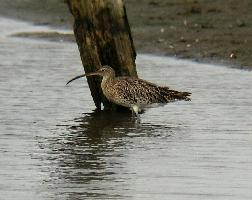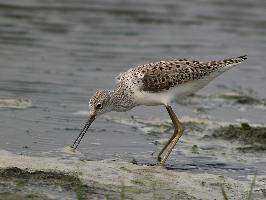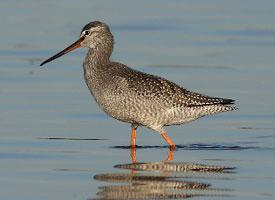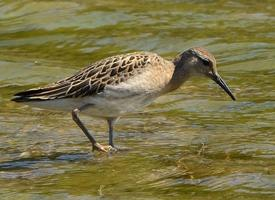
Popis zvířete
The Eurasian Curlew (Numenius arquata), often simply referred to as the curlew, is a large, migratory wading bird that belongs to the family Scolopacidae, which includes other shorebirds such as sandpipers and snipes. This species is notable for its long, down-curved bill, which is among the most distinctive features of its appearance and serves as an essential tool for foraging in mudflats, marshes, and shallow waters. The Eurasian Curlew is the largest wader found in its range, which extends across various parts of Europe, Asia, and Africa.Physical Description:
The Eurasian Curlew measures about 50-60 cm (20-24 inches) in length, with a wingspan that can reach up to 80-100 cm (31-39 inches), making it an impressively sized bird within its habitat. The bird's plumage is predominantly brown with a pattern of darker streaks and spots, which provides excellent camouflage against the mudflats and marshlands it frequents. Its underparts are paler, often a whitish or light brown color, with distinct streaking. The curlew's long, slender legs are bluish-grey or greenish-grey, enabling it to wade through shallow waters while searching for food.
One of the most remarkable features of the Eurasian Curlew is its long, curved bill, which can be up to 15 cm (6 inches) in length for some individuals. This bill is not just long but also highly sensitive, allowing the bird to detect and extract prey from mud and sand. The curvature and length of the bill vary between sexes, with females typically sporting a longer and more deeply curved bill than males.
Behavior and Ecology:
Eurasian Curlews are migratory birds, breeding in northern Europe and Asia and wintering in southern Europe, Africa, the Middle East, and South Asia. Their migration is a testament to their endurance and the global importance of conserving interconnected wetland habitats.
The diet of the Eurasian Curlew primarily consists of invertebrates, including worms, shellfish, and small crustaceans, which it skillfully extracts from mud and shallow water using its long bill. Occasionally, it may also feed on small fish and plant material.
The breeding season for Eurasian Curlews begins in late March or April, with nests typically located on the ground in open country, such as moorland, farmland, or open woodland. The nest is a simple scrape, lined with bits of vegetation. The female usually lays 3-4 eggs, which are incubated by both parents. The chicks are precocial, meaning they are relatively mature and mobile from the moment of hatching and are cared for by both parents, although they quickly learn to feed themselves.
Conservation Status:
The Eurasian Curlew is considered Near Threatened by the International Union for Conservation of Nature (IUCN), with declining populations across much of its range. The primary threats to this species include habitat loss due to agricultural expansion, drainage of wetlands, and disturbance from human activities. Climate change also poses a long-term threat by altering the bird's migratory patterns and the availability of its feeding and breeding habitats. Conservation efforts are focused on protecting important habitat sites, managing water levels in wetlands to ensure they remain suitable for feeding and breeding, and implementing policies that mitigate human disturbance.
In summary, the Eurasian Curlew is a distinctive and important species within the ecosystems it inhabits. Its unique physical characteristics, migratory behavior, and role in the food web underscore the need for concerted conservation efforts to ensure that future generations can continue to witness the haunting beauty of its long, melancholy calls across the world's wetlands.
Podobná zvířata
Nové fotografie zvířat
Top 10 zvířat
- Common cockchafer (Melolontha melolontha)
- Common house mosquito (Culex pipiens)
- Colossal squid (Mesonychoteuthis hamiltoni)
- Giant house spider (Eratigena atrica)
- Harpy eagle (Harpia harpyja)
- Fruit fly (Drosophila melanogaster)
- Common reed warbler (Acrocephalus scirpaceus)
- Australian box jelly (Chironex fleckeri)
- Proboscis monkey (Nasalis larvatus)
- Moustached guenon (Cercopithecus cephus)


